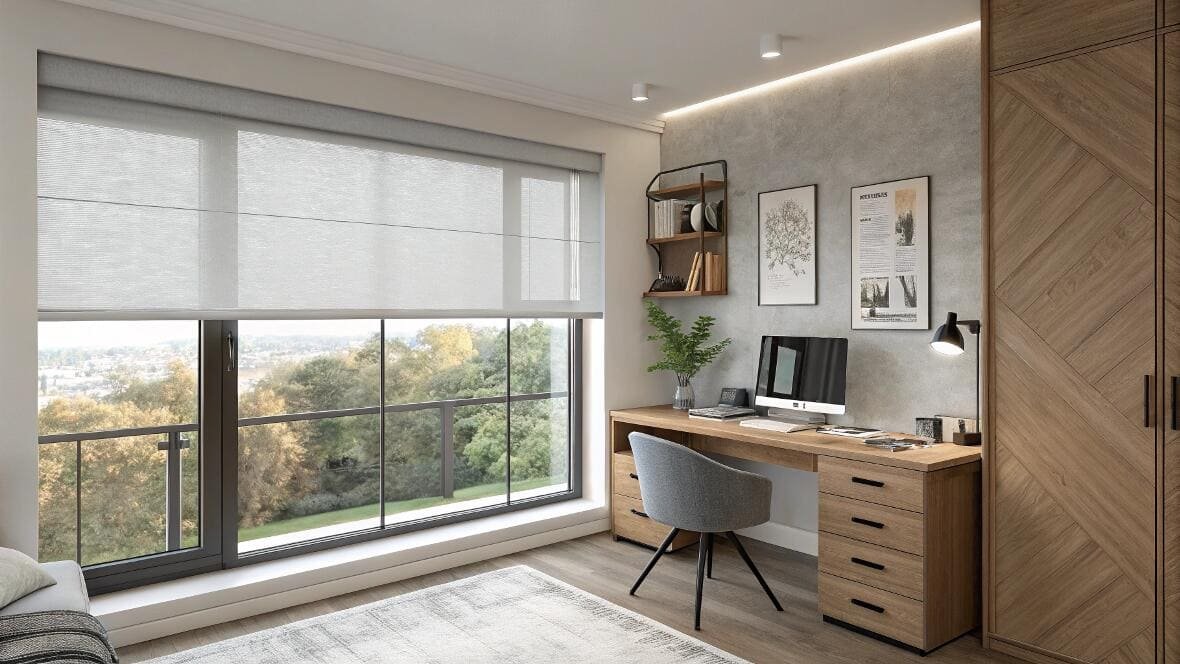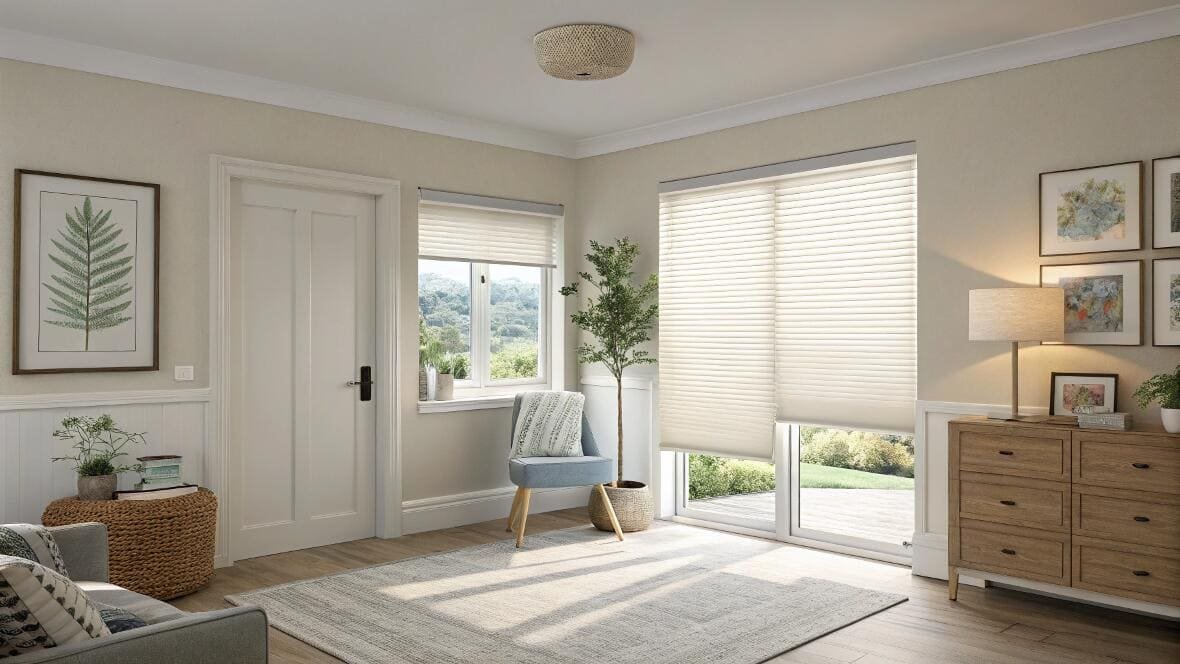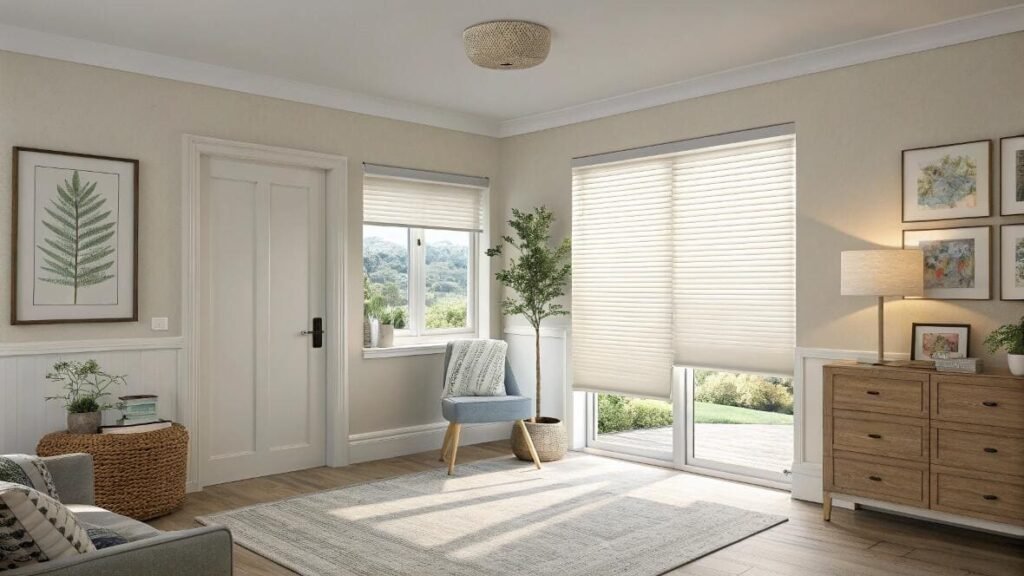Trying to keep your room cool in the summer but worried your blackout blinds are making it worse? It's a common fear that the very thing blocking the light is trapping the heat.
It depends on their color. Dark-colored blackout blinds absorb sunlight and radiate it as heat, making a room hotter. Light-colored blackout blinds with a reflective white backing are far more effective at reflecting heat away, keeping your space cooler.
[^1] offering a scenic outdoor view.](https://velablinds.com/wp-content/uploads/2025/07/1-131.jpg)
As a professional who supplies window treatments for commercial projects, I see this misunderstanding all the time. The term "blackout" can be misleading. While it perfectly describes the blind's ability to block light, it doesn't tell the whole story about heat management. The crucial factor isn't just blocking the light; it's what happens to the solar energy that the blind stops. A simple choice in color and material can mean the difference between a cool sanctuary and a stifling hotbox. Let's break down the science so you can make an informed decision for your next project.
Do dark blinds actually attract heat?
You've heard that black absorbs heat, but does that really make a difference for a window blind? It's easy to think any barrier against the sun will keep a room cool.
Dark blinds don't "attract" heat, but they absorb it very effectively. The dark surface converts sunlight into thermal energy, which then radiates into the room, raising the temperature. Light-colored blinds, on the other hand, reflect this energy back outside before it can turn into heat.
[^2] on large windows.](https://velablinds.com/wp-content/uploads/2025/07/2-130.jpg)
The physics here is simple but critical for any project where temperature control is a priority. Think of wearing a black shirt versus a white shirt on a sunny day; the black shirt gets much hotter. The same principle applies to your window treatments. The most important surface is the one facing the window, which is why most high-quality thermal and blackout blinds[^3] have a white or light-colored backing, regardless of the color facing into the room. A dark blind, especially one without a reflective backing, will absorb solar radiation, heat up, and then act like a small radiator right next to your window, working against your cooling efforts.
Here is a breakdown of how color impacts heat management:
| Color of Window-Facing Side | Solar Energy Interaction | Effect on Room Temperature |
|---|---|---|
| Dark (Black, Navy, Charcoal) | High Absorption | Absorbs solar energy and radiates it as heat, warming the room. |
| Light (White, Off-White, Silver) | High Reflection | Reflects solar energy away, keeping the room cooler. |
| Medium Colors | Moderate Absorption | A mix of absorption and reflection; less effective than light colors. |
For optimal cooling, always choose a blind with a light-colored or reflective exterior-facing side.
What blinds are best for cooling a room?
If dark blackout blinds can make a room hotter, what's the best alternative for keeping a space cool? You need a solution that effectively blocks solar heat gain, not just light.
Cellular (honeycomb) shades are the champions of cooling. Their unique honeycomb-shaped pockets trap air, creating a powerful insulating barrier. For roller shades, options with a white or metallic reflective backing are also highly effective at bouncing heat away from the window.

When clients ask me for the absolute best solution for temperature control, I almost always start with cellular shades. Their performance goes beyond simple reflection. They are engineered for insulation, which is measured by an R-value (resistance to heat flow). The higher the R-value, the better the insulation. A standard window has a very low R-value[^4], but adding a cellular shade can drastically improve it.
Here’s a look at the top-performing blind types for cooling:
- Cellular (Honeycomb) Shades: Their design is genius. The air pockets in their honeycomb structure[^5] slow down the transfer of heat, keeping your room cooler in the summer and warmer in the winter. Double-cell versions offer even more insulation than single-cell.
- Solar/Reflective Roller Shades: These are a fantastic modern option. They use special fabrics with a metallic or light-colored coating on the back that reflects a significant amount of solar radiation. The best part is that some versions are semi-transparent, so you can block the heat without losing your view.
- Light-Colored Venetian Blinds: Venetian blinds made from real wood, faux wood, or aluminum can be very effective. By tilting the slats upwards (with the rounded side facing out), you can reflect direct sunlight toward the ceiling, diffusing the light and keeping the heat from penetrating deeper into the room.
Ultimately, the best choice combines an insulating design with a reflective, light-colored surface facing the outside.
Which way should you turn blinds to keep a house cool?
You have venetian blinds, but you're not sure which way to tilt them. It seems like a small detail, but getting it right can make a noticeable difference in your room's temperature.
For horizontal blinds, you should tilt the slats up, so that the rounded, convex side is facing outwards. This angle is most effective at reflecting the sun's rays upwards and away from the room, preventing direct solar heat gain.

This is a simple trick that I share with every client who installs venetian blinds. It leverages the shape of the slat to your advantage. When tilted up, the slats overlap tightly and create a more solid barrier. The curved shape then acts like a small awning for the slat below it, guiding sunlight and heat up towards the ceiling instead of onto your floors and furniture. The light color of the ceiling helps to diffuse the remaining light without as much glare or heat.
In the winter, you would do the opposite. Tilting the slats down (with the rounded side facing in) helps to direct the warmth from the sun into the room, helping to warm the space naturally.
Here’s a quick guide for seasonal adjustments:
| Season | Goal | Slat Direction | How It Works |
|---|---|---|---|
| Summer | Keep Room Cooler | Tilt Slat UP (Convex side OUT) | Reflects sunlight upwards, away from the living space. |
| Winter | Keep Room Warmer | Tilt Slat DOWN (Convex side IN) | Directs radiant heat from the sun downwards into the room. |
Making this small adjustment at the start of each season can genuinely improve your home's energy efficiency and comfort level.
How do cellular vs. roller blackout blinds compare for thermal performance?
You've narrowed it down to either cellular or roller blinds for your project, but you need the best possible thermal performance. Which one truly delivers superior insulation against heat?
Cellular shades are significantly more effective for thermal insulation. Their honeycomb air pockets create an insulating barrier that slows heat transfer, whereas a roller blind primarily acts as a single-layer radiation barrier. While a good roller blind blocks heat, a cellular shade actively insulates against it.

When specifying blinds for a high-performance building or a room with extreme sun exposure, understanding the difference between blocking and insulating is critical. A blackout roller shade is great at blocking solar radiation—it stops the light from passing through. However, the fabric itself can still get hot and radiate that heat into the room.
A cellular shade does something more sophisticated. Its unique structure is designed to minimize heat transfer through conduction and convection.
- Cellular Shade Performance: The pockets of trapped air are poor conductors of heat. This "air gap" dramatically slows the movement of heat from the hot window glass to the inside of your room. Double-cell and triple-cell designs increase this effect even more. Studies from the U.S. Department of Energy have shown that a properly installed cellular shade can reduce unwanted solar heat gain by up to 60%.
- Roller Shade Performance: The effectiveness of a roller blind depends almost entirely on its reflective properties. A roller shade with a white or metallic backing will do a great job of reflecting solar energy. However, it provides very little insulating R-value on its own. It's an effective shield, but not an effective blanket.
| Feature | Cellular (Honeycomb) Blackout Shade | Roller Blackout Shade |
|---|---|---|
| Primary Mechanism | Insulation (Traps Air) | Reflection (Blocks Radiation) |
| Best-Case Heat Reduction | Up to 60% reduction in solar heat gain. | Up to 45% reduction in solar heat gain. |
| Winter Performance | Excellent at keeping heat in. | Moderate at keeping heat in. |
| Energy Savings | High potential for both cooling and heating. | Good potential for cooling, less for heating. |
For pure thermal performance and year-round energy efficiency, cellular shades are the superior technical choice.
Conclusion
The color and type of your blackout blinds are crucial. Dark blinds can make rooms hotter, while light-colored or specially coated blinds effectively keep them cool by reflecting sunlight.
Specify the Right Blinds for Your Project
Ready to choose the most effective blinds for temperature control and energy savings? Let's analyze your project needs and find the perfect solution that balances performance, aesthetics, and budget.
Contact me with your project details at info@velablinds.com to get started.
Extended FAQ Section
People also ask
Are white blackout blinds truly effective?
Yes, white blackout blinds are extremely effective and are one of the best choices for thermal control. The "white" aspect tackles heat reflection, while the "blackout" aspect ensures no light penetrates the fabric. The light-colored surface facing the window reflects a high percentage of solar radiation away before it can be absorbed. The opaque blackout construction then stops any remaining light from passing through. This dual-action approach makes them superior to dark-colored blackout blinds[^6] for keeping a room cool in the summer.
How much heat can window blinds actually block?
The effectiveness varies significantly by type, but high-performance blinds can block a substantial amount of heat. According to U.S. Department of Energy data, medium-colored draperies with white plastic backings can reduce heat gain by 33%. Highly reflective slatted blinds can reduce heat gain by about 45% when fully closed. The most effective option, insulated cellular shades, can reduce unwanted solar heat gain through windows by up to 60%. These reductions directly translate to lower energy consumption for air conditioning and a more comfortable indoor environment.
Should my blinds be open or closed on a hot day to keep the room cool?
You should absolutely keep your blinds closed during the hottest parts of the day. A window acts like a greenhouse, allowing solar radiation to enter and heat your home. Closing the blinds creates a barrier that blocks or reflects this incoming solar energy. Keeping them open allows the sun to heat your floors, furniture, and walls, which then radiate that heat into the room, raising the temperature significantly. The only exception is if you have dark, heat-absorbing blinds, where the benefit of closing them might be marginal.
---
[^1]: Discover how roller shades can effectively manage heat while maintaining aesthetics.
[^2]: Find out why cellular shades are considered the best for thermal insulation.
[^3]: Understanding blackout blinds is essential for effective heat management in your space.
[^4]: Understanding R-value can help you choose the best blinds for energy efficiency.
[^5]: Explore the unique design of honeycomb shades and their insulating properties.
[^6]: Discover the science behind dark-colored blinds and their impact on room temperature.Partner with VelaBlinds for Your Next Project
Smart window treatments shouldn't be complicated. After working with 500+ distributors and contractors worldwide, I've streamlined the process to get you quality products, competitive pricing, and reliable support - every time.
Why project professionals choose VelaBlinds:
- ✅ Fast, Accurate Quotes - Detailed specs and pricing within 24 hours
- ✅ Transparent Pricing - No hidden fees, volume discounts clearly outlined
- ✅ Quality Assurance - Direct partnerships with certified OEM manufacturers
- ✅ Project Support - Dedicated account manager from quote to delivery
Start your next project:
📧 Quick Quote: Send your requirements to info@velablinds.com
📱 Direct Contact: WhatsApp +86 137 2012 8317
🌐 Browse Solutions: https://velablinds.com/
📁 Product Resources: Access spec sheets, catalogs & project files
Jimmy Chen, Founder
"I built VelaBlinds to solve the real challenges I faced as a project buyer - long lead times, unclear specs, and unreliable suppliers. Let's discuss how we can power your projects with smarter blinds."
Serving distributors and contractors across North America, Europe, and Australia since 2018.




